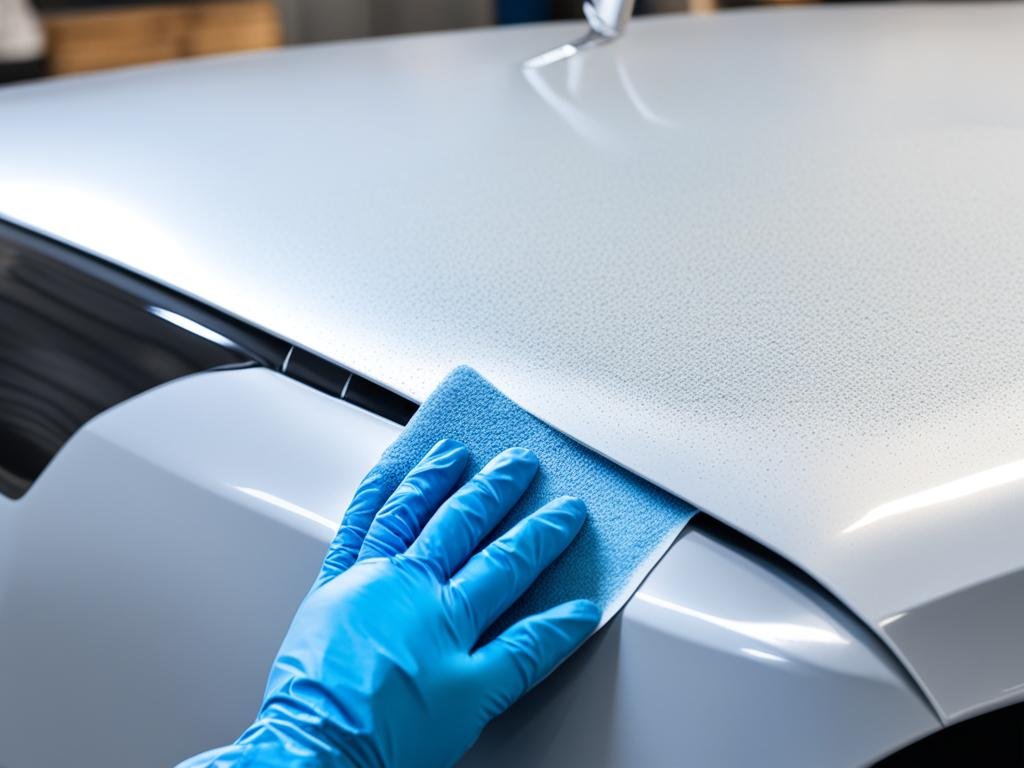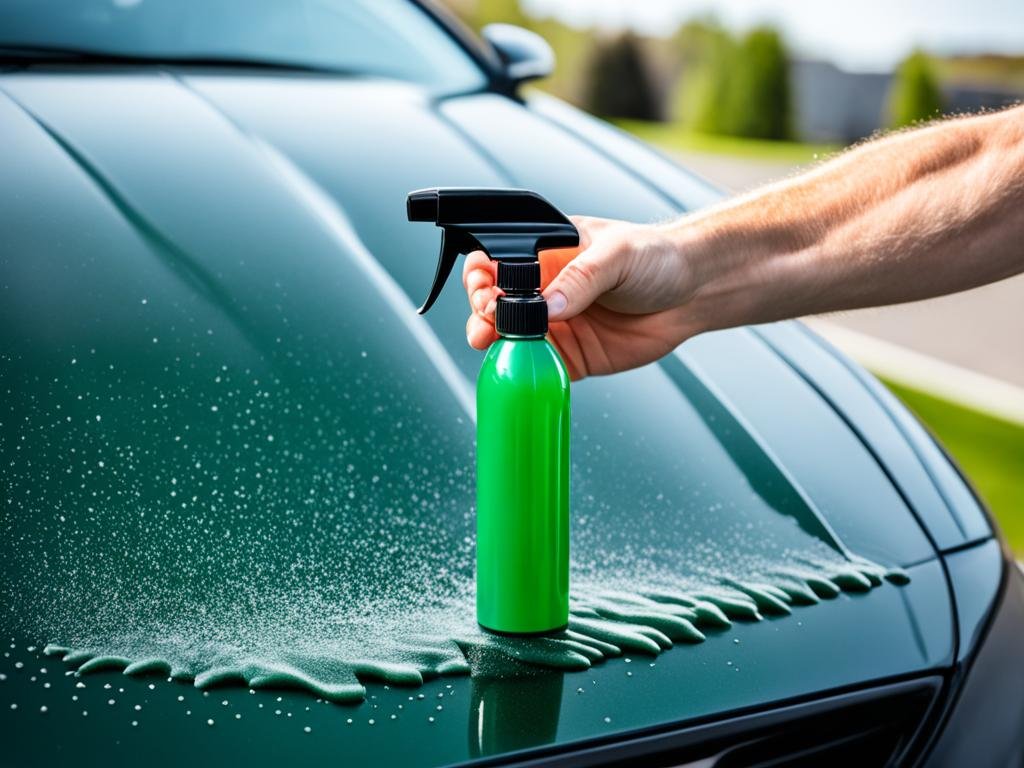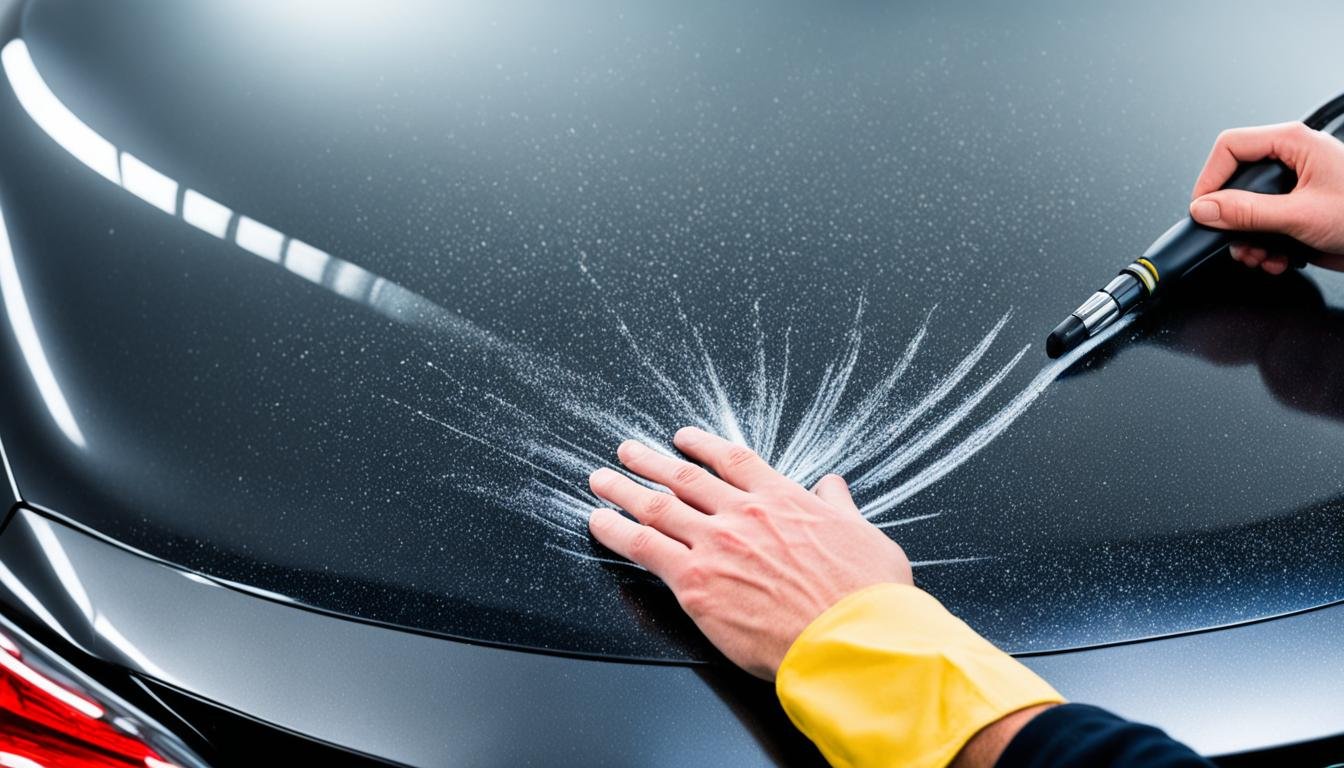How to Remove Paint Overspray Safely
April 11, 2024 | by Rosie Dazzlers
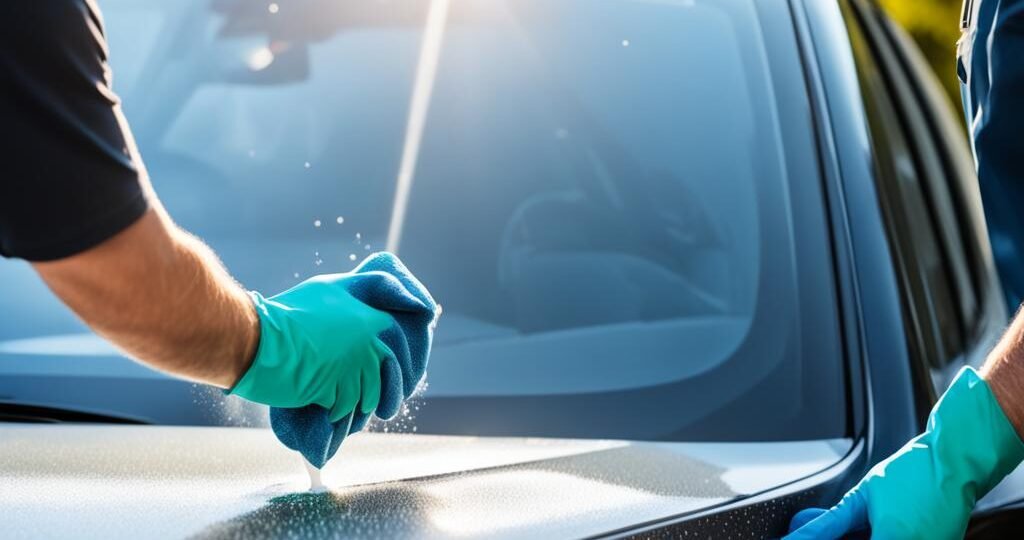
Serving Norfolk and Oxford counties, we bring the shine to you. From sedans to SUVs, experience unmatched convenience and quality right at your doorstep. Trust us to make your vehicle dazzle. Call now and let your car shine!
To safely remove paint overspray, there are various techniques and precautions that can be followed. Whether you’re dealing with overspray on your car, truck, or any other surface, our team at Rosie Dazzlers Mobile Auto Detailing is here to help. With our professional expertise and commitment to quality, we’ll make sure that your vehicle is restored to its original shine. Here are some safe techniques and tips for overspray removal:
Key Takeaways:
- Choose the appropriate overspray removal method based on the type of surface.
- Take necessary safety precautions to protect yourself and the surface.
- Consider using a clay bar, white vinegar, rubbing alcohol, or other suitable products depending on the type of overspray and surface.
- Test any products on a small area before applying them to the entire surface.
- For professional overspray removal services, trust the experts at Rosie Dazzlers Mobile Auto Detailing.
h1 {
text-align: center;
font-size: 28px;
color: #333;
padding: 10px;
}
h3 {
font-size: 20px;
color: #333;
margin-bottom: 10px;
}
p {
font-size: 16px;
color: #333;
line-height: 1.5;
}
Using a Clay Bar for Overspray Removal
A clay bar is a popular and effective tool for removing overspray from surfaces. It is widely available and can be purchased from big-box stores or online. The clay bar is specifically designed to gently lift and remove contaminants, including overspray, from the surface without causing damage.
Before using the clay bar, it is important to prepare the surface by softening or replacing the clay bar as needed. This ensures that the bar is in optimal condition to effectively remove the overspray.
To use the clay bar for overspray removal, follow these steps:
- Lubricate the surface containing the overspray with a suitable product. This could be a dedicated clay bar lubricant or a mixture of soap and water.
- Take a small piece of the clay bar and gently knead it in your hands to soften it.
- Apply light pressure and rub the clay bar over the area with overspray, moving in straight lines or a gentle circular motion.
- The clay bar will pick up the overspray as it glides over the surface. Continue working on the area until the majority of the overspray is removed.
- After using the clay bar, wipe away any residue with a spray cleaner or a microfiber cloth.
It is important to note that when using a clay bar, it is recommended to work on small sections at a time to ensure thorough and effective removal. Additionally, always follow the product instructions provided by the manufacturer for the best results.
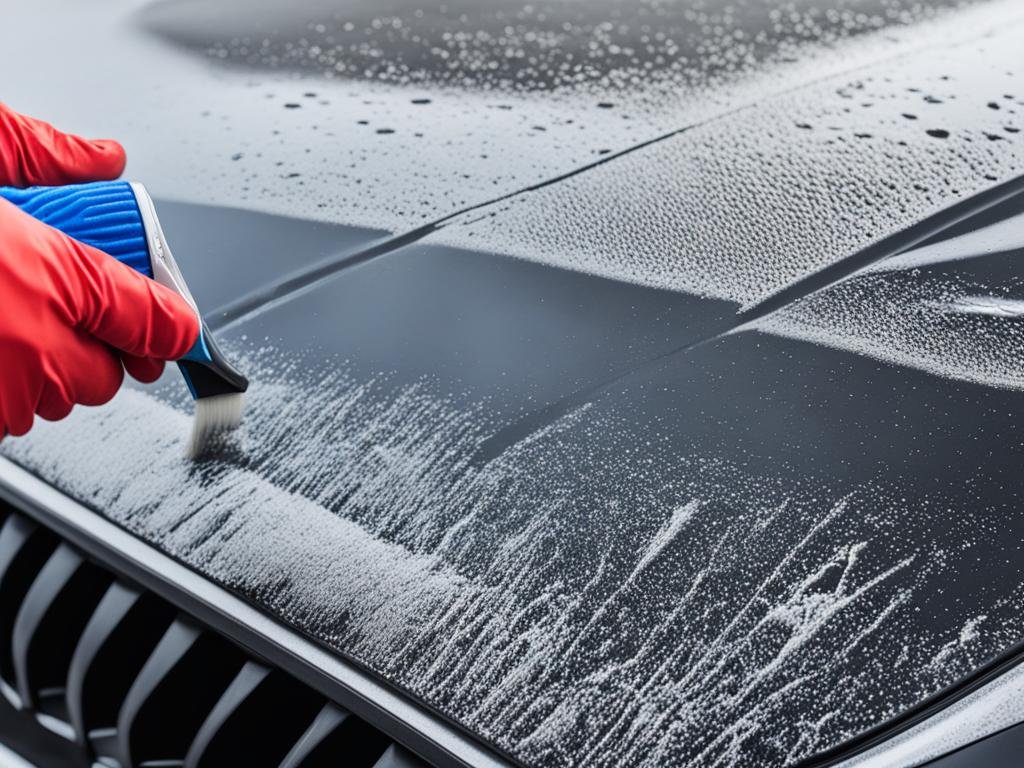
A clay bar is an excellent choice for overspray removal as it is gentle on the surface while effectively lifting and removing the unwanted paint. It is especially useful for removing overspray from painted surfaces, glass, and metal. However, it is always advisable to test the clay bar on a small, inconspicuous area before using it on the entire surface.
Using White Vinegar for Overspray Removal
White vinegar is a cost-effective and readily available solution for removing overspray from various surfaces. Its acidic properties help to break down the paint, making it easier to remove. Here’s a step-by-step guide on how to use white vinegar for DIY overspray removal:
- Boil white vinegar: Start by boiling a small amount of white vinegar in a pot. The heat will help to enhance its cleaning properties.
- Apply the vinegar: Once the vinegar has boiled, carefully pour it into a heat-resistant container. Using a clean rag, apply the hot vinegar to the overspray spots. Make sure to wear gloves to protect your hands.
- Allow it to sit: Let the vinegar sit on the overspray for a few minutes to allow it to penetrate the paint.
- Clean the spots: After the vinegar has had time to work its magic, create a mixture of warm water and mild soap. Use a clean cloth or sponge to gently scrub the overspray spots, removing any loosened paint.
- Scrape off remaining overspray: If there is still some overspray remaining on the surface, you can use a razor blade to carefully scrape it off. Be cautious not to scratch or damage the underlying material.
- Finish with glass cleaner: If you’re removing overspray from glass surfaces, such as windows or mirrors, finish off by spraying a glass cleaner and wiping away any residue.
White vinegar is a versatile household item that can be used for various cleaning tasks, including overspray removal. Its effectiveness and affordability make it a popular choice for DIY enthusiasts. However, it’s important to test any cleaning product on a small, inconspicuous area before applying it to the entire surface to ensure compatibility with the material.
Remember: When using any cleaning solution, always follow safety guidelines, wear protective gear, and work in a well-ventilated area.
| Pros | Cons |
|---|---|
| Cost-effective | May require multiple applications for stubborn overspray |
| Readily available | Strong odor |
| Natural and non-toxic | Potential to remove underlying wax or sealant |
Using Rubbing Alcohol for Overspray Removal
If you’re dealing with overspray, especially from latex paint, rubbing alcohol can be a highly effective solution. By following these simple steps, you can safely remove overspray without damaging the surface.
Gather your materials
Before starting the overspray removal process, make sure you have the following items:
- Rubbing alcohol
- Clean paper towels
- Soap and water
Apply rubbing alcohol
Pour a small amount of rubbing alcohol directly onto the overspray spot. Let it sit for a few minutes to allow the alcohol to dissolve the paint.
Wipe off the overspray
Using a clean paper towel, gently wipe off the dissolved paint. Be careful not to apply too much pressure, as it may cause damage to the surface.
Remove any residue
After wiping off the overspray, use soap and water to clean the area and remove any excess rubbing alcohol or residue. This will help restore the surface to its original condition.
Remember, it’s always recommended to test any products or methods on a small, inconspicuous area before applying them to the entire surface. This will ensure that the rubbing alcohol does not harm or discolor the material.
With its paint-dissolving properties, rubbing alcohol is a valuable tool for overspray removal. By following the steps outlined above, you can effectively eliminate overspray without causing any damage to the surface.
Stay tuned for the next section, where we’ll explore how to remove overspray from fabric using a surprising household ingredient.
Using Olive Oil for Fabric Overspray Removal
When it comes to removing spray paint overspray from fabric, olive oil can be a surprisingly effective solution. With just a few drops of this common household ingredient, you can restore your fabric to its original state. Here’s how:
- Apply Olive Oil: Start by applying a few drops of olive oil directly onto the fabric where the overspray is located. Make sure to cover the entire affected area. The olive oil will help to loosen the paint and make it easier to remove.
- Let it Soak: Allow the olive oil to soak into the fabric for a few minutes. This will give it time to break down the paint and make it more pliable.
- Scrape Off the Overspray: After the olive oil has had time to work its magic, take a plastic putty knife and gently scrape off the overspray. Be careful not to damage the fabric in the process. If necessary, repeat the previous steps until all of the overspray is removed.
Once the overspray has been scraped off, it’s important to remove the olive oil residue from the fabric. To do this:
- Use Turpentine: Dip a clean rag into turpentine and lightly dab the fabric to remove the olive oil residue. Turpentine is a solvent that can help dissolve the oil and lift it away from the fabric.
- Wash with Dish Soap: After using turpentine, wash the fabric with dish soap and warm water to fully remove any remaining oil residue. This will help to restore the fabric’s natural feel and appearance.
By following these steps, you can effectively remove spray paint overspray from fabric using olive oil. It’s a simple and cost-effective solution that can save you both time and money.
Removing Overspray from Different Surfaces
The method for removing overspray can vary depending on the surface. It’s essential to choose the most suitable technique to ensure effective and safe overspray removal. Here are some guidelines for removing overspray from different surfaces:
Wood
When dealing with overspray on wood surfaces, there are two primary options for removal:
- Chemical paint remover: Apply a suitable chemical paint remover according to the manufacturer’s instructions. Allow it to sit on the overspray for the recommended time before gently scraping off the softened paint. Take caution when using chemical removers and ensure proper ventilation.
- Sanding: If the overspray is only a thin layer or the chemical remover is not feasible, sanding can be an effective solution. Use sandpaper or a sanding block to gently remove the overspray in smooth, even motions. Remember to follow the wood grain for the best results.
Plastic
Overspray on plastic surfaces can be challenging to remove without causing damage. Consider the following methods:
- Rubbing alcohol: Dampen a cloth or cotton ball with rubbing alcohol and gently rub the overspray in circular motions until it lifts off. Test the rubbing alcohol in an inconspicuous area first to ensure it doesn’t discolor or damage the plastic.
- Non-acetone nail polish remover: Similar to rubbing alcohol, non-acetone nail polish remover can be effective for removing overspray from plastic. Apply it to a cloth and gently rub the affected area, being cautious not to scrub too vigorously.
Concrete
Removing overspray from concrete surfaces may require more intensive methods:
- Power washing: Use a pressure washer to remove loose overspray from the concrete surface. Adjust the pressure setting accordingly to prevent any damage to the concrete.
- Paint stripper or paint thinner: For more stubborn overspray, consider using a chemical paint stripper or paint thinner. Apply the product to the affected area, following the manufacturer’s instructions, and then use a brush or scraper to remove the paint residue.
Glass
Removing overspray from glass surfaces is generally easier compared to other materials. Consider the following options:
- Vinegar-water solution: Mix equal parts white vinegar and water in a spray bottle. Spray the solution onto the overspray and let it sit for a few minutes. Wipe the area clean with a soft cloth or squeegee, ensuring no streaks remain.
- Glass cleaner: Use a commercial glass cleaner and spray it directly onto the overspray. Wipe the area clean with a lint-free cloth or paper towel, ensuring a streak-free finish.
Remember to test any cleaning methods on a small, inconspicuous area first to ensure they won’t cause any damage or discoloration. Always follow safety precautions and use appropriate protective gear when handling chemicals or using power tools.
| Surface | Overspray Removal Methods |
|---|---|
| Wood | Chemical paint remover or sanding |
| Plastic | Rubbing alcohol or non-acetone nail polish remover |
| Concrete | Power washing or paint stripper/paint thinner |
| Glass | Vinegar-water solution or glass cleaner |
Preventing Overspray and Best Practices
To achieve a flawless paint job and prevent overspray, it is crucial to follow best practices for paint application. By using high-quality masking products, ensuring proper ventilation, and implementing effective preparation techniques, you can minimize the risk of overspray and achieve professional results.
Choosing the Right Masking Products
Investing in high-quality masking products is an essential step in preventing overspray. Use tape specifically designed for automotive painting, such as 3M Automotive Refinish Masking Tape. This tape offers excellent adhesion and clean removal, reducing the likelihood of paint bleeding or overspray. Additionally, consider using masking film or paper to cover larger areas, providing a reliable barrier against overspray.
Ensuring Proper Ventilation
A well-ventilated environment is crucial for preventing overspray and ensuring the health and safety of the painter. When painting indoors, ensure proper airflow by using exhaust fans, open windows, or professional paint booths equipped with ventilation systems. Adequate ventilation helps to dissipate overspray particles and reduce the chances of paint mist settling on unintended surfaces.
Cleaning the Surface before Painting
Thoroughly cleaning the surface before painting is another important step in preventing overspray. Remove any dirt, dust, or debris that may affect paint adhesion or cause uneven application. Use a mild detergent or automotive surface cleaner to ensure a clean and residue-free surface. Furthermore, consider using tack cloth to remove any remaining particles and promote a smooth paint finish.
| Best Practices for Preventing Overspray | Benefits |
|---|---|
| Use high-quality masking products | Minimizes paint bleeding, ensures clean removal |
| Ensure proper ventilation | Reduces overspray accumulation, improves air quality |
| Clean the surface before painting | Promotes paint adhesion, prevents debris-induced imperfections |
Using High-Quality Painting Equipment and Proper Technique
Investing in high-quality painting equipment, such as spray guns and air compressors, is essential for achieving precise and controlled paint application. Cheap or poorly maintained equipment can lead to overspray due to inconsistent paint flow or improper atomization. Additionally, mastering proper painting techniques, such as maintaining the correct spraying distance and using even strokes, can further minimize overspray.
We must always remember that prevention is key when it comes to overspray. By using the right masking products, ensuring proper ventilation, cleaning the surface, and employing high-quality equipment and techniques, we can significantly reduce the risk of overspray and achieve professional-grade paint finishes.
Implementing these best practices not only safeguards against overspray but also improves the efficiency of your paint application process. By taking proactive measures, you can save time, reduce rework, and deliver exceptional results.
Conclusion
Removing paint overspray safely is crucial to maintain the integrity of the underlying surface. By following the techniques and precautions discussed in this article, you can effectively remove overspray without causing damage. Whether you choose to use a clay bar, white vinegar, rubbing alcohol, or other methods, it is essential to test the products on a small area before proceeding and prioritize safety throughout the process.
When it comes to paint overspray removal, understanding the surface type is key. Different surfaces may require specific techniques and products. For wood, using a chemical paint remover or sanding may be necessary. Plastic surfaces can be cleaned with rubbing alcohol or non-acetone nail polish remover. Concrete surfaces can benefit from power washing and the use of paint stripper or paint thinner. For glass surfaces, a vinegar-water solution or glass cleaner can do the job effectively.
Prevention is always better than cure. To minimize overspray, use high-quality masking products, ensure proper vehicle and paint booth preparation, and employ correct painting techniques. Proper ventilation, surface cleaning, and the use of high-quality painting equipment are crucial elements to prevent overspray.
FAQ
What are some safe techniques for paint overspray removal?
There are several safe techniques for removing paint overspray, including using a clay bar, applying white vinegar, using rubbing alcohol, and using soap and water. The method you choose will depend on the type of surface and the type of overspray.
What is a clay bar and how does it help with overspray removal?
A clay bar is a tool that can be used to safely remove overspray from surfaces. It is available for purchase at big-box stores or online. It is important to soften or replace the clay bar as needed before using it. By lubricating the surface containing overspray and rubbing the clay bar over the overspray, it can be effectively removed. Any residue can be wiped off with a spray cleaner.
How can white vinegar be used to remove overspray?
White vinegar can be boiled and applied to overspray spots with a rag. The vinegar helps to loosen the paint. It is important to wear gloves while doing this. Afterward, a mixture of warm water and soap can be used to further clean the spots, and a razor blade can be used to scrape off any remaining overspray. The glass should be sprayed with a glass cleaner to remove any residue.
Can rubbing alcohol be used for overspray removal?
Yes, rubbing alcohol can be effective for removing overspray, especially latex paint. Pour a small amount of rubbing alcohol onto the overspray spot and wait for it to dissolve the paint. Wipe off the spot with a clean paper towel. Use soap and water to remove any excess rubbing alcohol or residue.
How can olive oil be used to remove overspray from fabric?
To remove overspray from fabric, apply a few drops of olive oil to the affected area and let it soak for a few minutes. Use a plastic putty knife to scrape off the overspray. To remove the olive oil from the fabric, wipe it with a rag dipped in turpentine and wash it with dish soap.
How do you remove overspray from different surfaces?
The method for removing overspray can vary depending on the surface. For wood, use a chemical paint remover or sand the paint off. Plastic surfaces can be cleaned with rubbing alcohol or non-acetone nail polish remover. Concrete surfaces can be power washed and then treated with a paint stripper or paint thinner. Glass surfaces can be cleaned with a vinegar-water solution or glass cleaner.
How can overspray be prevented?
To prevent overspray, use high-quality masking products and properly prepare the vehicle and paint booth. This includes choosing the right masking products, ensuring proper ventilation, and cleaning the surface before painting. The use of high-quality painting equipment and proper technique can also help minimize overspray.
What are the best practices for paint application to reduce overspray?
Some best practices for paint application to reduce overspray include using the correct air pressure, maintaining proper distance from the surface, using overlapping strokes, and applying multiple thin coats instead of one thick coat. It is also important to follow the manufacturer’s instructions for the specific paint being used.
Source Links
RELATED POSTS
View all

